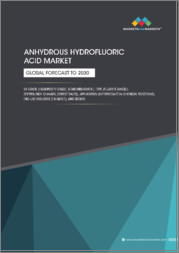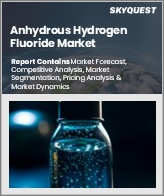
|
시장보고서
상품코드
1628062
세계의 무수 불화수소 시장 : 기회, 성장 촉진요인, 산업 동향 분석 및 예측(2025-2034년)Anhydrous Hydrogen Fluoride Market Opportunity, Growth Drivers, Industry Trend Analysis, and Forecast 2025 to 2034 |
||||||
무수 불화수소(AHF) 세계 시장은 2024년에 23억 달러로 평가되어 2025년부터 2034년까지 CAGR 6.2%를 나타낼 것으로 예측됩니다.
이러한 성장은 혁신 촉진, 제품 최적화, 유통망 확대로 시장 역학을 재구성하는 업계 리더들 간의 파트너십 증가에 크게 기여합니다. 이러한 제휴를 통해 기업은 진화하는 고객 수요에 적응하고 경쟁력을 강화하며 새로운 기회를 찾을 수 있습니다.
전략적 제휴는 지식 공유, 기술 발전, 신흥 시장 접근을 촉진함으로써 시장 확대를 추진하는 데 중요한 역할을 합니다. 전문 지식을 모아 업계 각사는 고품질 제품에 대한 수요에 부응하여 시장 성장을 더욱 강화하고 있습니다. 이러한 집단적 접근은 다양한 분야에서 AHF 수요 증가를 유지하는데 매우 중요합니다.
그러나 AHF는 위험한 성질 때문에 운송과 사용을 규제하는 엄격한 규제 등 시장은 주목해야 할 과제에 직면하고 있습니다. 원료 비용의 변동이나 불소의 배출에 관한 환경 문제도 큰 장벽이 되고 있습니다. 지속 가능한 성장과 경영의 안정을 보장하기 위해서는 이러한 문제를 해결하는 것이 필수적입니다.
| 시장 범위 | |
|---|---|
| 시작연도 | 2024 |
| 예측연도 | 2025-2034 |
| 시작금액 | 23억 달러 |
| 예측 금액 | 42억 달러 |
| CAGR | 6.2% |
AHF는 전자 부품의 제조에 필수적인 에칭 및 세정 공정에 사용되는 반도체 제조에 중요한 역할을 담당하고 있습니다. 급속한 기술 진보에 대응하기 위해 반도체 산업이 확대됨에 따라 고순도 AHF 수요가 증가하고 있습니다. 또한 AHF는 의약품, 농약, 냉매 등의 분야에 필수적인 불소 함유 화합물의 생산에 있어서 중요한 재료로서의 역할을 하고 있습니다. 이러한 화합물은 제품의 성능을 향상시키는 독특한 특성을 평가하여 AHF 시장 관련성을 더욱 향상시키고 있습니다.
석유화학 산업에서 AHF는 정제 공정에 필수적이며 보다 깨끗한 연료 생산을 지원합니다. 에너지 수요 증가를 배경으로 한 이 부문의 성장은 안정적이고 효율적인 화학 원료로서 AHF의 중요성을 강조합니다.
주요 응용 분야인 불소 수지는 2034년까지 16억 달러에 이르고, CAGR 6.2%로 성장할 것으로 예측됩니다. 이러한 재료는 탁월한 내화학성과 열 안정성으로 모든 산업에서 널리 사용됩니다. 마찬가지로 2024년 시장 점유율의 25.2%를 차지한 화학산업은 앞으로도 다양한 용도로 AHF 수요를 견인해 나갈 것으로 보입니다.
미국 시장은 대폭적인 성장이 예상되며, 2034년에는 CAGR 5.6%로 7억 1,280만 달러에 달할 것으로 예측되고 있습니다. 전자 및 화학제품과 같은 주요 부문 수요 증가는 이 성장을 지원하고 중요한 산업 자재로서 AHF의 지위를 확고하게합니다.
목차
제1장 조사 방법과 조사 범위
제2장 주요 요약
제3장 업계 인사이트
- 생태계 분석
- 밸류체인에 영향을 주는 요인
- 이익률 분석
- 파괴
- 미래 전망
- 제조업체
- 유통업체
- 공급자의 상황
- 이익률 분석
- 주요 뉴스와 대처
- 규제 상황
- 영향요인
- 업계에 미치는 영향요인
- 성장 촉진요인
- 반도체 제조를 위한 수요 증가
- 불소 함유 화합물의 제조 용도 증가
- 석유화학산업의 알킬화 공정에서의 사용 확대
- 시장의 과제
- 독성으로 인한 엄격한 환경 및 안전 규정
- 성장 촉진요인
- 규제와 시장에 미치는 영향
- Porter's Five Forces 분석
- PESTEL 분석
제4장 경쟁 구도
- 소개
- 기업 점유율 분석
- 경쟁 포지셔닝 매트릭스
- 전략 전망 매트릭스
제5장 시장 규모와 예측 : 용도별, 2021-2034년
- 주요 동향
- 불소수지
- 불소가스
- 살충제
- 기타
제6장 시장 규모와 예측 : 최종 용도별, 2021-2034년
- 주요 동향
- 화학산업
- 반도체 산업
- 일렉트로닉스 산업
- 자동차산업
- 기타
제7장 시장 규모와 예측 : 지역별, 2021-2034년
- 주요 동향
- 북미
- 미국
- 캐나다
- 유럽
- 영국
- 독일
- 프랑스
- 이탈리아
- 스페인
- 러시아
- 아시아태평양
- 중국
- 인도
- 일본
- 한국
- 호주
- 라틴아메리카
- 브라질
- 멕시코
- 중동 및 아프리카
- 남아프리카
- 사우디아라비아
- 아랍에미리트(UAE)
제8장 기업 프로파일
- Air Products and Chemicals, Inc.
- Daikin Industries, Ltd.
- GFL Limited
- Honeywell International Inc.
- Linde Plc
- Mexichem SAB de CV
- Mitsui Chemicals, Inc.
- Navin Fluorine International Limited
- Puyang Huicheng Electronic Material Co., Ltd
- Sinochem Lantian Co., Ltd.
The Global Anhydrous Hydrogen Fluoride Market, valued at USD 2.3 billion in 2024, is anticipated to grow at a CAGR of 6.2% from 2025 to 2034. This growth is largely attributed to increasing partnerships among industry leaders, which are reshaping market dynamics by fostering innovation, optimizing products, and expanding distribution networks. These collaborations enable companies to adapt to evolving customer demands, enhance competitiveness, and explore new opportunities.
Strategic alliances play a crucial role in driving market expansion by facilitating knowledge sharing, technological advancements, and access to emerging markets. By leveraging combined expertise, industry players are meeting the demand for high-quality products, further boosting market growth. This collective approach is pivotal in sustaining the increasing demand for AHF across various sectors.
However, the market faces notable challenges, including strict regulations governing its transport and use due to its hazardous nature. Fluctuating raw material costs and environmental concerns related to fluoride emissions also pose significant barriers. Addressing these issues is essential for ensuring sustainable growth and operational stability.
| Market Scope | |
|---|---|
| Start Year | 2024 |
| Forecast Year | 2025-2034 |
| Start Value | $2.3 Billion |
| Forecast Value | $4.2 Billion |
| CAGR | 6.2% |
AHF is critical in semiconductor manufacturing, where it is used for etching and cleaning processes essential to producing electronic components. As the semiconductor industry expands to accommodate rapid technological advancements, the demand for high-purity AHF continues to rise. Additionally, AHF serves as a key input in the production of fluorine-containing compounds, which are integral to sectors like pharmaceuticals, agrochemicals, and refrigerants. These compounds are valued for their unique properties that enhance product performance, further driving AHF's market relevance.
In the petrochemical industry, AHF is vital for refining processes, supporting the production of cleaner fuels. The sector's growth, fueled by increasing energy demands, underscores the importance of AHF as a reliable and efficient chemical input.
Fluoropolymers, a major application segment, are projected to reach USD 1.6 billion by 2034, growing at a 6.2% CAGR. These materials are widely utilized across industries due to their exceptional chemical resistance and thermal stability. Similarly, the chemical industry, which accounted for 25.2% of the market share in 2024, will continue to drive demand for AHF in various applications.
The U.S. market is poised for substantial growth, with a projected value of USD 712.8 million by 2034 at a 5.6% CAGR. Increasing demand from key sectors like electronics and chemicals underpins this growth, solidifying AHF's position as a critical industrial input.
Table of Contents
Chapter 1 Methodology & Scope
- 1.1 Market scope & definition
- 1.2 Base estimates & calculations
- 1.3 Forecast calculation
- 1.4 Data sources
- 1.4.1 Primary
- 1.4.2 Secondary
- 1.4.2.1 Paid sources
- 1.4.2.2 Public sources
Chapter 2 Executive Summary
- 2.1 Industry synopsis, 2021-2034
Chapter 3 Industry Insights
- 3.1 Industry ecosystem analysis
- 3.1.1 Factor affecting the value chain
- 3.1.2 Profit margin analysis
- 3.1.3 Disruptions
- 3.1.4 Future outlook
- 3.1.5 Manufacturers
- 3.1.6 Distributors
- 3.2 Supplier landscape
- 3.3 Profit margin analysis
- 3.4 Key news & initiatives
- 3.5 Regulatory landscape
- 3.6 Impact forces
- 3.7 Industry impact forces
- 3.7.1 Growth drivers
- 3.7.1.1 Increasing demand in semiconductor manufacturing.
- 3.7.1.2 Rising applications in the production of fluorine-containing compounds.
- 3.7.1.3 Expanding use in the petrochemical industry for alkylation processes.
- 3.7.2 Market challenges
- 3.7.2.1 Stringent environmental and safety regulations due to toxicity.
- 3.7.1 Growth drivers
- 3.8 Regulations & market impact
- 3.9 Porter's analysis
- 3.10 PESTEL analysis
Chapter 4 Competitive Landscape, 2024
- 4.1 Introduction
- 4.2 Company market share analysis
- 4.3 Competitive positioning matrix
- 4.4 Strategic outlook matrix
Chapter 5 Market Size and Forecast, By Application, 2021-2034 (USD Billion) (Kilo Tons)
- 5.1 Key trends
- 5.2 Fluoropolymers
- 5.3 Fluorogases
- 5.4 Pesticides
- 5.5 Others
Chapter 6 Market Size and Forecast, By End Use, 2021-2034 (USD Billion) (Kilo Tons)
- 6.1 Key trends
- 6.2 Chemical industry
- 6.3 Semiconductor industry
- 6.4 Electronics industry
- 6.5 Automotive industry
- 6.6 Others
Chapter 7 Market Size and Forecast, By Region, 2021-2034 (USD Billion) (Kilo Tons)
- 7.1 Key trends
- 7.2 North America
- 7.2.1 U.S.
- 7.2.2 Canada
- 7.3 Europe
- 7.3.1 UK
- 7.3.2 Germany
- 7.3.3 France
- 7.3.4 Italy
- 7.3.5 Spain
- 7.3.6 Russia
- 7.4 Asia Pacific
- 7.4.1 China
- 7.4.2 India
- 7.4.3 Japan
- 7.4.4 South Korea
- 7.4.5 Australia
- 7.5 Latin America
- 7.5.1 Brazil
- 7.5.2 Mexico
- 7.6 MEA
- 7.6.1 South Africa
- 7.6.2 Saudi Arabia
- 7.6.3 UAE
Chapter 8 Company Profiles
- 8.1 Air Products and Chemicals, Inc.
- 8.2 Daikin Industries, Ltd.
- 8.3 GFL Limited
- 8.4 Honeywell International Inc.
- 8.5 Linde Plc
- 8.6 Mexichem S.A.B. de C.V.
- 8.7 Mitsui Chemicals, Inc.
- 8.8 Navin Fluorine International Limited
- 8.9 Puyang Huicheng Electronic Material Co., Ltd
- 8.10 Sinochem Lantian Co., Ltd.



















